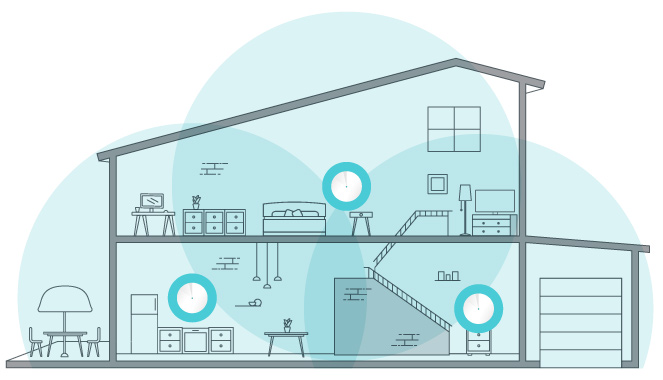It seems like everything in our lives has the word smart as part of its title — smart thermostats, smart appliances smartphones … the list goes on. All those devices rely on the same thing to keep them functioning, and that is a powerful Wi-Fi signal. If you’re planning on creating your dream smart home, it’s vital to ensure your network can keep up. How can you set up your home Wi-Fi so it can handle all these different devices?
Wi-Fi for Smart Homes

Before you start investing in smart appliances and other networked devices, it’s important to make sure you have decent high-speed internet and Wi-Fi capability. If you’re still on your ISP’s cheapest plan or haven’t upgraded your internet service since the days of AOL, that should be your first step. Talk to your internet service provider. You might be surprised how much cheaper it is to switch to high-speed internet than it is to maintain your current speeds. It’s more cost-effective than it used to be, and you shouldn’t set up a smart Wi-Fi network without it.
Omnidirectional vs. Beamformed Wi-Fi
Traditional wifi signals are omnidirectional. You plug in your router, hook up your internet and send the wireless signal out in all directions. This is usually sufficient for things like cellphones and laptop computers, but walls, electrical wires and other appliances can interfere with the signal. Relying on this omnidirectional signal can be problematic if you’ve got smart devices spread throughout your home. Beamformed Wi-Fi, as its name suggests, transmits the wireless signal in a tight beam directly from the router to the device.
For devices that are at a distance from the router, beamforming might seem like the perfect solution.
Setting up Your Home Wi-Fi Network
Setting up a Wi-Fi network capable of supporting a smart home isn’t difficult, but it can take some work. As long as you have broadband internet, the only thing you need to do is make sure you’re a strong signal throughout your home. For a single-story apartment or house, a single router is usually sufficient. However, if you have a room or two on the outskirts that aren’t getting a decent signal, consider adding a Wi-Fi booster or installing a mesh network.
Instead of relying on or boosting the signal from a single router, mesh networks use multiple broadcast points so you’re getting the same signal strength throughout the house. Each node in a mesh network uses the same name, so you can walk from room to room without losing signal on your mobile devices.
Finally, make sure you secure your mobile network with a strong password, MAC address filtering or other security measures. If a savvy hacker gets into your unsecured Wi-Fi network, they can make off with credit card numbers and additional personal information you’ve entered into websites while connected to your home network.
Things to Remember
If you don’t have high-speed broadband internet, make that your first step before setting up a Wi-Fi network for your smart home. Without that foundation, you’ll find yourself scrambling to keep your devices connected where they can do the most good. Once you have your internet, all you need to do is install a router or use a mesh network to ensure every device receives a strong Wi-Fi signal. Beamformed Wi-Fi is also an option, but it requires making sure all your devices are beam compatible.
Don’t let this discourage you from setting up the smart home of your dreams. Just make sure you’ve got everything established before you start installing things that rely on your Wi-Fi to function.

I may be getting old, but I don’t trust these devices that are always on, always listening to your voice, and always connected to some server at Google or Amazon. These servers know who you are (you need an account to use them), where you live, what you order online, what music you listen to, who your friends are (isn’t it great to grant Facebook access to your Google contacts to better “link with your friends”)? They track your every step thanks to GPS in your phone. Having IoT in your house is, essentially, giving control over your home to those companies. Who knows how they will use it?
It may be convenient to have some AI figure out your habits and set the thermostat to the right temperature without you actually programming it 10 minutes before you arrive home from work. But doesn’t it feel creepy? And is it really more convenient than just turning the knob on the wall?
It’s also an endless lure to buy more and more sophisticated devices. You install a thermostat and, all of a sudden you have to upgrade your whole WiFi – get a new more expensive contract, more expensive equipment, larger monthly payments for everything. Next thing you know is that the app controlling the temperature from your smartphone doesn’t work on your phone you used for the last 5 years and you have to buy a new phone, and so on. Things that seemingly intend to make our life easier and more enjoyable, in fact, make it more complicated.
LikeLike